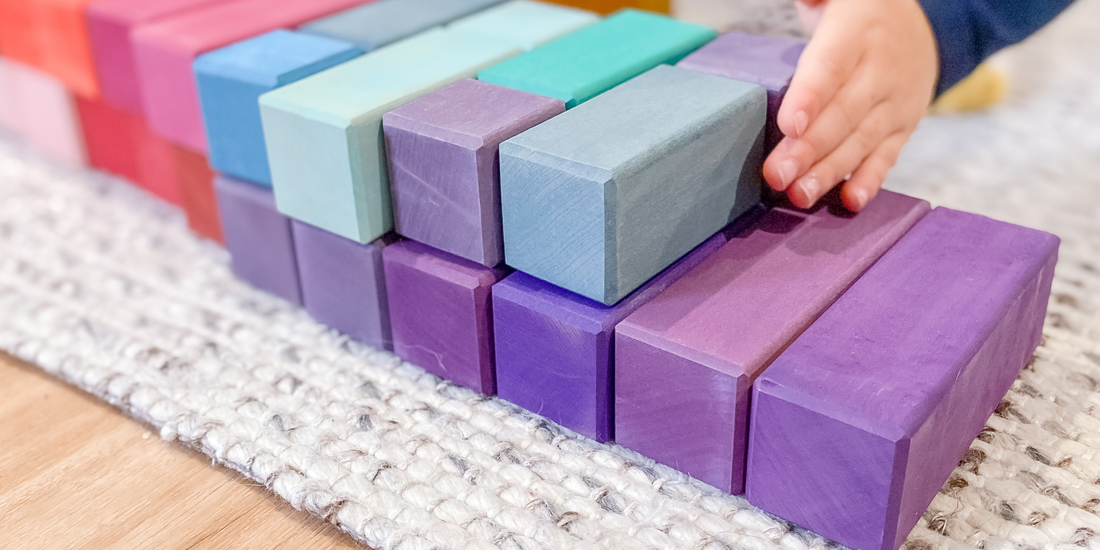Have you ever sat back and watched your little one and thought, "what on earth is going on here?" In a world where social media bombards us with an influx of play advice, I sometimes find myself wondering what's truly worth sharing and what might be missing the mark. It's not uncommon to see educators and parents putting their hearts into extending their child's learning through play. Don't get me wrong; any effort invested with thought and intention is commendable. However, sometimes, amidst the rush to "teach" information, we miss the intricate workings of the young mind at play. This is where understanding Play Schemas, or Schematic Play, can change the way we perceive our role in play and revolutionize the way we observe and comprehend our child's learning journey.
What Is Schematic Play?
Schematic play may sound like a fancy term, but it's actually something we've all seen during our children's everyday escapades. There are many different types and I'll explain the main ones later on, so scroll down if you don't care about the theory behind them.
If you are with me still, picture your little one joyfully hauling their toys around the house in a bag, seemingly without a care in the world, or the repetitive delight of dropping a ball down a pipe and watching it roll out at the bottom. These seemingly simple activities are all rooted in the world of schemas. At its core, schematic play is a natural process where children repeatedly explore and experiment with specific themes or concepts, known as "schemas". These schemas are like mental blueprints that help our children make sense of the world around them. They explore these concepts by repeating certain behaviours and actions in their play until the mind has consolidated the theory it's been exploring. The remarkable thing is that we don't need to teach schemas - they unfold naturally as children interact with their environment. Our role as adults is to identify the schema at play and work to provide an environment that supports the schema to be explored.
Why? Well maybe the most enticing reason is that it will support your child to explore independently in their own mind and allow you a minute to get what you need done. It will also support their brain growth and executive (thinking) skills.

Schemas offer us a window into understanding our children's play at a deeper level than "they like animal play"
For instance, when a child plays with a toy horse and barn, it might not necessarily indicate an interest in horses but instead suggest engagement with an enclosing schema, where they explore hiding or fitting objects inside other objects. Recognising this can broaden the possibilities for providing play opportunities that align with their current developmental focus on enclosing things, rather than simply adding more farm theme play.
What does your ability to park your car have to do with Schemas?
Let's stay with the theme of enclosing and take, for instance, the intriguing connection between schematic play and our ability to gauge whether our car can fit into a parking space. It all goes back to those early days when children engage in "enclosing" behaviors during play helps their spatial awareness. That time when they're trying to squeeze all their alphabet magnets into that narrow crevice between the fridge and the wall instead of playing with them on the fridge's surface like we intended. It might seem like a simple playtime diversion, but it's actually a profound exploration of space and depth. This kind of play isn't primarily about learning letters; it's about understanding the world around them, one space at a time!
By engaging in schematic play, children develop their understanding of the way the world works, which supports their cognitive and executive functioning skills. However, enough with the theory; let's dive into what they are, how they manifest in play, and the valuable learning experiences hidden within each one.

Transporting Schema: Satisfaction with moving things from one place to another


Transporting Schema may be one of the easiest schemas to understand, as the definition is in the title. It shows up when a child takes a keen interest in transporting or moving items from one place to another.
How it shows up in play:
When children are carrying things in a basket, bag, wheelbarrow, or cart OR moving things from one space to another, either from one container to another or right across the room to a whole new space! The key is that the satisfaction of the play is in the process of the transportation not necessarily the destination or what the item being transported will be used for.
The challenge with this schema is it can easily be interpreted as making mess for the sake of making mess. Setting up stations or invitations to "transport" may make this schematic play easier to swallow.
What the brain learns: spatial awareness, understanding how objects move and interact within their environment, fostering important cognitive and social development.
good resources for transporting around could include our new rings and coins set or have you checked out our giant loose parts kit?
Positioning Schema: Lining up and Sorting items thoughtfully.


The positioning schema is an early play pattern that centers around arranging and positioning objects in relation to similarities and differences. Think about sorting and positioning buy size, colour or type (grouping all horses together and lining them up from smallest to largest)
This is often the most pleasing schema for adults to observe as everything has order and seems more purposeful than other schemas.
How it shows up in play: Children exhibiting this schema might meticulously line up their toys, stack blocks in specific patterns, or arrange items in a particular order.
What the brain learns: Spatial relationships, symmetry, and order. The positioning schema helps them grasp the concept of how objects can be organized and placed in various configurations, promoting early mathematical concepts.
We recommend our Pyramid block set, or actually anything that can be sequenced or arranged in a particular way.
Trajectory Schema: The Fascination with Paths & Motion


The trajectory schema revolves around the fascination with paths, motion, and the way objects move through space. Children exhibiting this schema are learning concepts of direction, speed, and velocity. It's a fundamental way for them to explore and understand the dynamics of motion in their environment.
How It Shows Up in Play:
Children with a trajectory schema are deeply intrigued by paths and motion. They engage in activities like rolling balls down slopes and conduct experiments with objects to understand how they move along different pathways. Whether it's repeatedly sliding a ball down a ramp, pretending to be racing drivers, or repeatedly dropping their sippy cup from the highchair,
This schema can be interpreted as misbehavior due to the throwing and dropping nature it comes with. Planning activities where this is allowed is helpful to reduce frustration.
What the Brain Learns: distance, speed, direction and angles
Our open ended range includes everything you need to make epic ball runs that support this schema. Or have you seen the learn and grow magnetic ball run?
Enveloping / Enclosing Schema: Hiding and Barricading items


The enveloping or enclosing schema are often referred to interchangeably and both are about concealing objects or oneself from view, closely tied to the concept of object permanence. The understanding that objects continue to exist even when they are out of sight. It is also linked with understanding their own body and mathematical concepts around space and volume; hence the enclosing may involve making borders around areas.
How It Shows Up in Play:
Children with this schema often engage in activities like hiding objects, making things disappear, wrapping presents, using "envelopes" for drawings or letters, and layering artwork with additional markings. In the early stages peek a boo, posting activities and play silks will be your child's best friend. The enclosing schema may show up with a repeated behaviour of making "fences and walls" for themselves or toys.
What the Brain Learns: Object permanence, spacial awareness, space and volume
Resources to support include: Playsilkies, Nesting Cubes Planks
Transformation Schema: Change & Metamorphosis


The transforming schema is all about change and metamorphosis, and it often emerges in a child's early play skills. Sensory play is a winner for this schema - Check out the Play Recipe cards here!
How it shows up in play:
You might notice them joyfully mixing paint colors to discover new shades, molding clay into various shapes, or engaging in imaginative play where objects and characters undergo magical transformations.
This Schema can get messy very quickly, planning things like cooking experiences or making playdough are a great one to feed this schema.
What the brain learns: cause and effect, creativity, problem-solving, and the concept of change itself, which lays the groundwork for more complex cognitive processes as they grow.
Rotation Schema: Let's spin EVERYTHANGGGG!


The rotation schema is an early play pattern that revolves around spinning, turning, or circular movements.
How it shows up in play: A fascination with objects that rotate, such as spinning tops, fans, or even themselves twirling around.
What their brain learns: Through activities like these, their developing brains are learning about concepts related to symmetry, patterns, and the physics of rotational motion.
Resources that support this schema? lawn mower roller car set
Connecting Schema: Putting things together!


Just as it sounds, the connecting schema is a repeated pattern of connecting items together.
How it shows up in play: links, chains, or networks. You might observe them stringing beads, building intricate structures with magnetic tiles or even forming the good old daisy chain.
What the brain learns: brains are learning about connections, patterns, and cooperation. The connecting schema not only enhances their spatial awareness and fine motor skills but an understanding about how systems work.
Our number one resource for this schema is our magnetic tile range
Conclusion
Exploring kids' schematic play is like taking a deep dive into the awesome world of childhood development. It's all about encouraging their creativity, helping them become little problem solvers, and even giving their emotions a growth spurt.
As parents and teachers, it's our job to be their cheerleaders and make sure they have the time, space, and tools they need to get deep into their favorite schemas. That way, we're setting them up for success in the future while also celebrating their wild imaginations and super cool creative skills.

